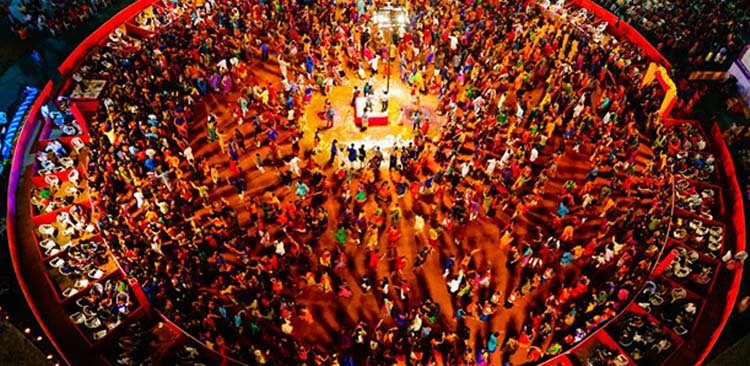|
Listen to article
Getting your Trinity Audio player ready...
|

Captivating visuals of happy people playing Garba and Dandia come straight to mind when one thinks of the celebration of the Sharad Navratri in Gujarat. These two lively folk dances of Gujarat, which now are performed across the globe, have deep spiritual roots and are a form of worship.
Mahishasur was a powerful demon King and devotee of Brahma. And from Brahma he asked for a boon, that no man would ever be able to defeat him. He asked for such a boon as he believed that a woman could never be strong enough to challenge him. Brahma granted him his boon, which made him almost invincible, but he then started using his powers for evil. The Dev’s were helpless against this onslaught so they went to seek the protection of Ma Durga (also referred to as Ma Ambe), beseeching her to slay the demon.
And so it came to pass that the Supreme Mother Goddess, took to battle with Mahishasur, which lasted all of nine days and nine nights before Mahishasur was annihilated. Surely, Ma Durga could have destroyed the demon with a blink of Her eyelids, but through this battle she chose to send a message to mankind, that no matter how strong the forces of adharma may seem and howsoever long the battle may last, we must never give up, we must fight adharma unabated. It could take the very last bit of one’s resolve, but in the end, it is Dharma that will reign victorious.
To commemorate the battle and in veneration of Ma Durga, these nine nights are celebrated as the festival of Navratri. All across India, the festival is celebrated with great devotion and enthusiasm. In Gujarat lies the additional joy of worship and celebration through its dance forms —Garba and Dandia Raas.
The terms Garba and Dandia Raas are sometimes used interchangeably but they are different. The former traditionally refers to the sacred hymns sung in the Devi’s honour. The dances to them are also called Garba today. Being a form of worship they are performed around a murti of Ma Ambe beside which is placed a perforated clay pot, which encloses a lit diya. The clay pot symbolises a womb and the light emanating from the jyoti, symbolises life growing within. As Garbha in Sanskrit means womb, this clay pot has been named Garbha-deep. Interestingly, a similar clay pot is used for the ‘ghat sthapana’ for Durga Puja celebrations across North India.
The Garba is an expression of veneration and worship of the female form of the divine. Through it, the devotees express love and gratitude towards the Goddess who fought for us and inspires us to reach out to the energy within, to destroy all evil within and outside us.
Children, young and the elderly, everyone joins in the community celebration, which is irresistible and loved by all. As the people go round and round the Garba–deep, in numerous concentric circles, they replicate both, the cosmos with the heavenly bodies on their orbits as well as the energy at the tiniest level, in the cellular form in the atom. Being a form of worship, the Garba is performed barefoot. Symbolically, we surrender our ego, and as our feet touch the earth, we accept ourselves as one with the elements.
As the dance progresses, the music increases in pace and the dance more euphoric. This, even when so many are on strict ‘upwas’ and may have to report to work the next day. Every street of Gujarat comes to life to the beats of Garba on these nine nights. Each region has their specific Garba steps and movements. In fact, the Nagar community of Gujarat celebrates ‘Bethe Garba’ which means sitting Garba. Here, devotees gather in small groups at someone’s home and sing Garbas, the Sadhana and Stuti is the main focus and a little bit Garba may be played later. Just like in ‘Mata ka Jagrata’ of North India, during the Bethe Garba, devotees use only simple tabla and manjira. The Bethe Garba started in Junagarh during the Islamic rule, when the Nizam forbade Hindus from celebrating their festivals in public.
Raas is the other enthralling dance performed during Navratri. Most are aware that it is related to Lord Krishna and his Raas Leela. Hymns to Him are also sung during Navratri. The word Dandia actually refers to the decorated bamboo sticks which the dancers hold in each hand. The Raas too, is an energetic dance, and through its performance, the devotees recreate the gruesome battle Ma Ambe fought with Mahishasur, the sticks in the hands representing the swords in the hands of the Goddess and the grounds around them the battlefield. Interestingly, in the Rajkot district of Gujarat, Talwar Raas is practised by women and recently they set a world record for the same.
These celebrations are endorphin inducing events and are looked forward to, many weeks in advance. Elaborate colourful traditional wear is prepared for all, men women and children. Registrations to dance classes rise as everyone wants to perfect their moves. Such celebrations have multiple roles to play. They bring communities closer, enhance the joy of festivals and keep traditions thriving. Navratri is the time we seek inspiration from Ma Durga, to be completely intolerant of all injustice and adharma. A time to purge ourselves from all negativity that we may have allowed to creep into our thought, minds and into our society and to reinforce the ancient truth that good will always triumph over evil.






Add comment